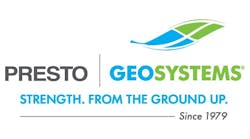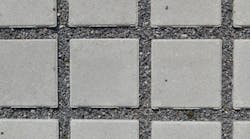In 2012, Hurricane Sandy devastated the Atlantic coast—causing significant damage to coastal communities in many mid-Atlantic states. During the hurricane, wind and water surges breached barrier islands and coastal protection, causing unprecedented flooding which destroyed businesses, homes, trees, power lines and pavements.
A luxury car dealership in Brooklyn, N.Y. lost a protective bulkhead and land, sustaining significant damage to their asphalt vehicle parking area from the storm’s flooding. Total pavement reconstruction was necessary for fleet parking.
However, stringent new regulations put in place after Hurricane Sandy for flood-prone areas, eliminated a completely asphalted surface as an option. New pavements were required to be designed so that all sheet flow was captured on site utilizing stormwater detention systems.
New York representative Bill Ragen, Ragen Associates, presented the dealership’s project engineer and contractor the Presto Geosystems’ Geopave aggregate pavers.
Because rigorous everyday traffic was anticipated, the Geopave pavers with aggregate infill, was specified to provide a long-term porous surface over approximately half of the 2.5-acre parking lot. The remaining area was to be paved with asphalt.
The project superintendent with the general contractor visited a similar site where Geopave pavement had been in use for four years with no maintenance. With both the owner and contractor convinced that the Geopave system was the right solution for this site, the project superintendent worked to obtain the necessary regulatory approvals. The Geopave system met all regulatory requirements and was approved by the NY State Department of Environmental Conservation (DEC).
A deep base of 18 in. of varying-sized aggregate was designed under the Geopave pavers for maximum storm water storage. The bottom layer consisted of 12 in. of 3/4 in aggregate, followed by a middle layer of 4 in. of 1/2 in and the top 2 in. was a leveling layer of finer grain stone. Infill in the Geopave units consisted of 0.375 in. to 0.5 in. aggregate with minimal fine content.
Geopave pavers confine open-graded aggregate, delivering high rates of infiltration to minimize storm water runoff. Water flows through the pavement layer into the storm water retention base layer for storage and ultimately natural percolation. The Geopave system’s molded mesh bottom keeps aggregate from moving even under high vehicle traffic and offers a stiff resistance to loading stresses.







